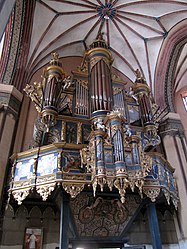Organs of the Frauenburg Cathedral
| Organs of the Frauenburg Cathedral | |
|---|---|
| General | |
| place | Cathedral of the Assumption |
| Organ builder | E. Kemper & Son , Lübeck / Bartenstein |
| Construction year | 1935 |
| Last renovation / restoration | Kamiński, 1977–1979 |
| epoch | 20th century |
| Organ landscape | East Prussia |
| Illustrations | |
|
Prospectus with positive return |
|
| Technical specifications | |
| Number of pipes | about 5,000 |
| Number of registers | 49 + 16 |
| Number of manuals | 5 |
The organs of the Frauenburg Cathedral are among the most important in northern Poland . The main organ in the baroque prospectus from 1685 has 49 stops , the choir organ 16. Both are operated from a common console by control lines.
history
Organ by Hans Hauck 1506
The first known construction of an organ in the Frauenburg Cathedral by Hans von Konitz (Hans Hauck) has been handed down from 1506 . This was destroyed by Swedish troops between 1629 and 1635.
Organ by Daniel Nitrowski 1685
From 1683 to 1685 Daniel Nitrowski from Gdansk built a new instrument with 27 registers and three manuals. The prospectus has been preserved to this day. This organ had to be repaired several times because the wood was only of mediocre quality. Repairs were carried out by Adam Horatio Casparini , Frölich, Max Terletzki (1882) and Bruno Goebel (1930) , among others .
Organ by E. Kemper & Sohn 1935
In 1935 the company E. Kemper & Sohn from Lübeck, which had a branch in Bartenstein , East Prussia , was commissioned to restore the Nitrowski organ. This had built a reputation for itself through good restorations of historical baroque organs. Since the condition of the instrument was very bad, it was decided to completely rebuild it. A choir organ was also built. Both should be able to be operated from a gaming table by means of electrical control cables. The main organ had three manuals, the choir organ one with 13 registers.
Repairs and extensions
The organs were severely damaged in 1944 and 1945. In the 1960s they were repaired by Józef Sianko, Truszczyński, Sobiechowski and Dominik Biernacki, and in 1970 they were repaired by Kamiński. From 1977 to 1979 this organ building company carried out modifications and extensions. Another manual was added for the main organ, some registers were changed, some were added. The organ was to be brought closer to the baroque organ by Nitrowski from 1685 in terms of disposition and sound.
In 2013 new keyboards were installed in the manuals and the pedal, and other work was carried out. Installation of a pedal 32 'is planned.
Organs
The main organ on the west gallery has four manuals with 49 registers . The choir organ is on the side gallery above the entrance to the George Chapel. It can be heard by opening the blinds both in the choir and in the aisle. It has 16 stops on two manuals. Both organs are played from a common console, connected by electrical control cables . There are some effect registers such as cymbals, cuckoo calls, nightingales and pedal thunder.
The disposition of the main organ is
|
|
|
|
|
|||||||||||||||||||||||||||||||||||||||||||||||||||||||||||||||||||||||||||||||||||||||||||||||||||||||||||||||||||||||||||||||||||||||||||||||||||||||||||||||||
-
Pairing :
- Normal coupling: I / II, III / II, IV / II, V / II, III / I, IV / I, V / I, IV / III, V / III, V / IV, I / P, II / P, III / P, IV / P, V / P
- Secondary register : animation Stella (star), Angelica (angel)
- Playing aids : 3 free combinations , 1 fixed combination (tutti), crescendo roller , choir organ: blinds to the aisle and choir, automatic pedal I, II
Technical specifications
-
Action :
- Sound action: electro-pneumatic
- Stop action: electro-pneumatic
literature
- Wiktor Z. Łynak: Prawda i falsz o zabytkowych organach katedry w Fromborku. [Truth and lie about the historic organ in the Frauenburg Cathedral] . In: Komunikaty Mazursko-Warmińskie . No. 3. 1996. pp. 409-425, with a German summary p. 425. PDF
Web links
- Frombork Archikatedra Orgues France (French)
- Organ in the Frauenburg Cathedral Museum Frombork (German)
Individual evidence
- ↑ Werner Renkewitz , Jan Janca , Hermann Fischer : History of the art of organ building in East and West Prussia from 1333 to 1944. Volume II, 2: From Johann Preuss to E. Kemper & Sohn, Lübeck / Bartenstein. Siebenquart, Cologne 2015. pp. 629–633.
- ↑ Werner Kreth: Kemper organs in the cathedral in Frauenburg. Garbe, Reinfeld in Holstein 1935
- ↑ Archikatedra Frombork MusicamSacram (Polish)
- ↑ Frombork. Katedra (organy główne). Polskie Wirtualne Centrum Organowe, June 22, 2004, archived from the original on March 5, 2016 ; Retrieved January 1, 1900 .
